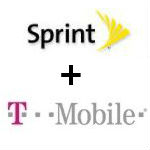 If T-Mobile Sprint merger plans are approved by regulators, the merged company would have the network capacity required to quickly create a “broad and deep” 5G nationwide network in “the critical first years of the 5G innovation cycle,” said T-Mobile and Sprint in announcing their merger plans yesterday. T-Mobile Sprint 5G plans call for using Sprint’s mid-band (2.5 GHz) spectrum, along with T-Mobile’s nationwide low-band (600 MHz) spectrum and “other combined assets.”
If T-Mobile Sprint merger plans are approved by regulators, the merged company would have the network capacity required to quickly create a “broad and deep” 5G nationwide network in “the critical first years of the 5G innovation cycle,” said T-Mobile and Sprint in announcing their merger plans yesterday. T-Mobile Sprint 5G plans call for using Sprint’s mid-band (2.5 GHz) spectrum, along with T-Mobile’s nationwide low-band (600 MHz) spectrum and “other combined assets.”
According to the merger partners, neither AT&T nor Verizon can rapidly build a nationwide 5G network because to do so, they either must kick current customers off LTE or use high-band (millimeter wave) spectrum that has very short range and therefore would require a much broader buildout.
T-Mobile Sprint 5G Plans
The 5G network that Sprint and T-Mobile propose to build if the merger is approved – a big “if” — would deliver 15 times faster speeds, on average, in comparison with T-Mobile’s current network by 2024, according to yesterday’s press release.
According to Wirefly research released earlier this month, T-Mobile’s average download speed was 17 Mbps as of fourth quarter 2017, which would put the merged company’s 5G speed at 255 Mbps by 2024.
T-Mobile did not immediately respond to an inquiry from Telecompetitor asking what speeds the 5G network would support at initial launch, but Iain Gillott, president of iGR Research, told Telecompetitor he estimates initial speeds at no more than 100 Mbps. That would be a substantial improvement in comparison with what any carrier is getting over LTE today, he said, but not as fast as what AT&T will get in those areas where it deploys 5G in millimeter wave bands. And what goes for AT&T is likely to go for Verizon as well.
AT&T and Verizon have been touting the faster speeds that 5G in millimeter wave spectrum can support, albeit over shorter distances. The higher-speed claims are based, at least in part, on the wider swaths of spectrum available in millimeter wave bands.
AT&T said recently that it had achieved gigabit speeds using 5G in millimeter wave spectrum in an unusually wide 400 MHz channel over a distance of 150 meters (about 492 feet) without line of sight in a field test. The company also noted, though, that it won’t offer such high speeds at initial launch, nor will it rely totally on millimeter wave spectrum. The service also will be deployed in low- and mid-band spectrum bands, the company said.
Verizon also plans to use lower-frequency spectrum in addition to millimeter wave spectrum to support 5G.
Meanwhile, the U.S. is getting set to auction millimeter wave spectrum, potentially giving a merged T-Mobile Sprint the ability to acquire such spectrum.
Long-term, that means all three major carriers (assuming the T-Mobile Sprint deal goes through) could deploy 5G in low-band, mid-band and millimeter wave spectrum in which case, Gillott said, “at the end, you end up with networks that look relatively similar.”
Initially, however, “everybody is focusing on a different aspect of 5G,” Gillott noted.
While AT&T and Verizon may be able to tout faster speeds in limited areas, T-Mobile or a merged T-Mobile Sprint would emphasize geographic coverage.
T-Mobile already has announced plans to deploy 5G nationwide using 600 MHz spectrum, merger or no merger. A key question for the regulators tasked with determining whether to approve the deal will be to determine how much value Sprint’s mid-band spectrum adds to T-Mobile’s initial geographic edge in the race to 5G and more broadly to T-Mobile’s long-term 5G plans.


